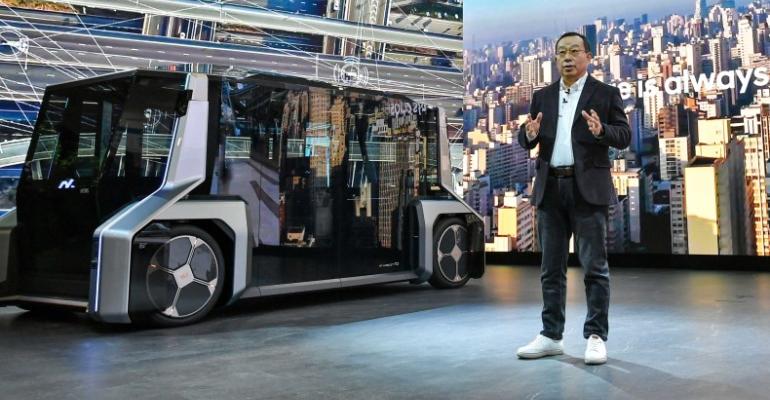LAS VEGAS – Like most other major automotive suppliers, Hyundai Mobis is preparing for the seismic technological shift created by the move to electrification and automation – and the hardware and software driving it.
At CES 2023, the Korean company announced it will prioritize providing an integrated hardware and software mobility platform over its legacy business of producing individual vehicle parts.
And like most other major suppliers and OEMs, Hyundai Mobis is also partnering with chipmaker Qualcomm to develop automated driving technology.
Hyundai Mobis President Cho Sung-hwan acknowledges the future presents challenges but also opportunities.
“This road map is not so simple though we need to connect the dots of various sectors,” he says. “We'll secure hardware and software fusion capability and provide more than just units of parts.”
To demonstrate its new strategy and technology prowess, Hyundai Mobis debuted its M.Vision To and M.Vision Hi autonomous and all-electric shuttles that use a battery-powered “pillar module” drivetrain on the four corners of the vehicles. Each power a Hyundai Mobis’ “e-corner” wheel assembly (below) that rotates 90° to allow the vehicle to pivot in a tight circle and “crab walk” sideways.
The company says the technology provides “a wide range of applications, from driving in narrow downtown street or transporting cargo” and that the shape and size of the platform is scalable for various applications. The company also showed a Hyundai Ioniq 5 EV passenger vehicle using the e-corner technology in a testing situation.
Beyond this type of drivetrain and maneuverability, which have been used on other AV shuttles, the M.Vision concepts feature cameras, radar and lidar sensors integrated into the four corner pillars of the vehicles. Inside, eye-scanning technology uses the gaze of passengers as a remote controller and the four sides of the cabin glass can be used to project online content.
Hyundai Mobis also announced it’s developing an SAE Level 3 autonomous driving controller utilizing Qualcomm’s Snapdragon Ride cloud connected ADAS platform. To further aid automakers in rolling out automated-driving features, Hyundai Mobis additionally said its teaming up with Ottopia to implement the Israeli start-up’s Remote Mobility Assistance teleoperations technology for Level-4 and higher systems.
Hyundai Mobis says it expects the development project with Qualcomm to be completed in the first half of 2023 resulting in an uptick in orders from automakers for ADAS and automated-driving systems.
But Cheon Jae-seung, head of the company’s Future Technology Convergence Institute, tells The Korean Herald that implementing the e-corner system in mass-produced vehicles initially will be difficult.
He adds, however, that the technology shown on the M.Vision concepts “embody the future of e-drive actuators, sensors and HMI through added emphasis on software, semiconductors and integrated controllers on any architecture.”
President Cho Sung-hwan also acknowledges the new path facing Hyundai Mobis as well as other major automotive suppliers will not be business as usual. “For this we step out of the box and face new challenges to achieve future innovation,” he says.





